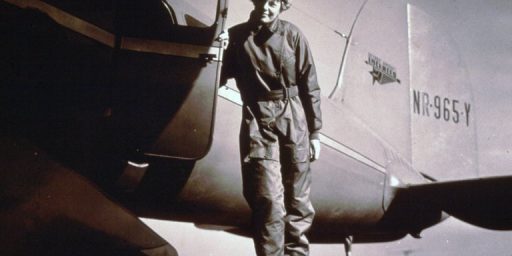Evidence Indicates Early Jamestown Settlers Resorted To Cannibalism
Newly discovered evidence seems to indicate that the settlers at Jamestown, the first successful British settlement in North America, faced such severe hardship in the early years that they resorted to cannibalism:
Archaeologists excavating a trash pit at the Jamestown colony site in Virginia have found the first physical evidence of cannibalism among the desperate population, corroborating written accounts left behind by witnesses. Cut marks on the skull and skeleton of a 14-year-old girl show that her flesh and brain were removed, presumably to be eaten by the starving colonists during the harsh winter of 1609.
The remains were excavated by archaeologists led by William Kelso of Preservation Virginia, a private nonprofit group, and analyzed by Douglas Owsley, a physical anthropologist at the National Museum of Natural History in Washington. The skull bears tentative cuts to the forehead, followed by four strikes to the back of the head, one of which split the skull open, according to an article in Smithsonian magazine, where the find was reported Wednesday.
It is unclear how the girl died, but she was almost certainly dead and buried before her remains were butchered. According to a letter written in 1625 by George Percy, president of Jamestown during the starvation period, the famine was so intense “thatt notheinge was Spared to mainteyne Lyfe and to doe those things which seame incredible, as to digge upp deade corpes outt of graves and to eate them.” Five other historical accounts refer to cannibalism during the Jamestown siege.
The girl’s remains were discovered last summer in a refuse dump containing horse and dog bones. From the state of her molars, she is judged to have been 14 years old. Isotopes in her bones indicate that she had eaten a high-protein diet, so she was probably not a maidservant but the daughter of a gentleman.
Dr. Owsley said in an interview that he could tell she was English because of his familiarity with English skeletal remains of the 17th century and from scientific tests. The ratio of oxygen isotopes in her bones indicated that she had grown up in the southern coastal regions of England, Dr. Owsley said, and the carbon isotopes pointed to a diet that included English rye and barley.
James Horn, a historian with the Colonial Williamsburg Foundation, said at a news conference on Wednesday that the young woman probably had arrived on one of the six surviving ships from a supply fleet that sailed from Plymouth, England, in early June of 1609. A week short of its destination, the fleet was scattered by a hurricane. The flagship, named the Sea Venture, which carried the expedition’s leaders, was driven onto reefs at Bermuda, an event that became the inspiration for Shakespeare’s play “The Tempest,” Dr. Horn said.
In mid-August, six of the ships eventually reached Jamestown. But their arrival, with little food and many extra mouths, did not bring relief or comfort. The settlers’ insistent demands for food antagonized the Powhatan Indians, who at first had welcomed and provisioned them. In October or early November, with about 300 colonists crowded into the narrow confines of the James fort, the Powhatans launched a full-scale attack and siege, cutting off any hope of outside relief.
People began eating leather from their clothes and boots and killing their horses, cats and dogs. Those who ventured into the woods in search of roots were killed by Indians. “Only in the most desperate of circumstances would the English have turned to cannibalism,” Dr. Horn said.
The colony was saved in May 1610 by the arrival of the settlers who had been marooned in Bermuda. They found the 60 survivors as thin as skeletons. In June 1610, another relief fleet arrived, commanded by Lord De La Warr, who would later lend his name to the state of Delaware. De La Warr’s men swept the grisly remains of the siege — dog and horse bones and those of at least one person — into the refuse pile that Dr. Kelso and his colleagues have just begun to excavate.
Had these relief forces not arrived when they did, it’s likely that Jamestown would have slipped into the mists of history along with its predecessor the ,Roanoke Colony and history would likely have been very different.






Seems a bit of a jump to go from one corpse to it being a widespread practice at the colony. It’s like declaring that cannibalism was common in Milwuake in the 1980s because you found Jeffrey Dahmer’s refrigerator.
So, America was founded by cannibals. Those of us with a perverse sense of humor have got to kind of love that.
I guess the next meeting of the Jamestowne Society will have something to talk about. Or more likely, not.
@Stormy Dragon:
Well.
About 12% survived.
The situation is a lot more comparable to the Donner Party than Milwaukee in the 1980s…
@PJ:
Yes, but the fact the remains were found in the trash instead of being reburied suggests the flying colonial people-eater in question was forced to indulge surreptitiously.
@michael reynolds: “So, America was founded by cannibals. Those of us with a perverse sense of humor have got to kind of love that. ”
See, that’s why Republicans keep eating their own — it’s a tribute to our founding fathers’ founding fathers!
@PJ: “I guess the next meeting of the Jamestowne Society will have something to talk about.. ”
To start with, who’s bringing the snacks…
@Stormy Dragon:
The reason for why the remains were found in the trash:
And other corpses may very well have been dug up, eaten, and reburied, the article only mentions that they are excavating the refuse pile.
Actually, it wasn’t the relief ships that saved them as they rapidly went back indolence and were just as vulnerable to the next lean times. That is until the governor threw off socialism and permitted private property and private initiative.
@JKB: They were indentured servants. Does that fit your definition of socialism?
Colonist 1: “You seem down. Is something eating you?”
Colonist 2: “Yes. YOU.”
They were still indentured servants when permitted to own property and control at least a portion of their own production. Whether the socialism was by agreement as in the Plymouth colony or created by contract as in Jamestown, it remains that secure property rights is what spurs men to productive labor not “from each according to ability and to each according to needs”. In more recent times, look to the reforms in rural China that eased the socialism under the Communist Party permitting the farmers to control a portion of their production. This reform ignited the transformation we see in China today even as the Party maintains the hold on the reins of political power.
“The colonists were indolent because most of them were indentured servants, expected to toil for seven years and contribute the fruits of their labor to the common store.”
@JKB: If you ever find yourself hospitalized in Canada don’t ask too many questions when dinner arrives.
Interesting as my maternal ancestors (Huston) arrived at Jamestown in 1612, a few years after this. They were Protestant Irish who had been forced out of Ireland (the 16th century intolerance of the Catholic Irish is not a topic to be discussed). [yes 16th, initial emigration to Scotland happened in the 1500’s, their emigration to Americas in 1600s ]